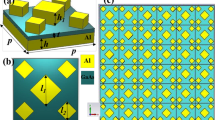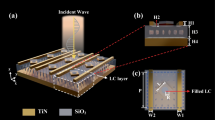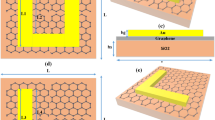Abstract
We propose a broadband solar metamaterial absorber based on a Ti-SiO2-Ti-SiO2-Fe2O3 five-layer configuration. The optimized parameters of the configuration are obtained from the deep neural network with Keras in Python. The average absorptance of the absorber can achieve 98.70% in the wavelength range from 170 nm to 900 nm under the normal incidence. The absorber is not sensitive to the incident angle of the polarized light. When the incident angle of light is not greater than 40°, the average absorptance of the absorber can reach over 90% for both x- and y- polarized lights. In addition, different polarization angles in the range of 0–90° have almost no effect on the absorptance of the absorber. The proposed absorber has potential applications in many fields, such as solar energy absorption, ultraviolet protection and near-infrared detection.







Similar content being viewed by others
Data Availability
The data sets used and/or analyzed during the current study are available from the corresponding author on reasonable request.
References
Sun P et al (2023) Metamaterial ultra-wideband solar absorbers based on a multi-layer structure with cross etching. Phys Chem Chem Phys 25(14):10136–10142
Qi B et al (2023) A near-perfect metamaterial selective absorber for high-efficiency solar photothermal conversion. Int J Therm Sci 194
Li X et al (2023) Ultra-broadband solar energy absorber based on Ti and TiN from visible to mid-infrared. Phys Scr 98(10)
Han S et al (2016) Broadband solar thermal absorber based on optical metamaterials for high-temperature applications. Adv Opt Mater 4(8):1265–1273
Zheng Y et al (2022) High efficiency Titanium oxides and nitrides ultra-broadband solar energy absorber and thermal emitter from 200 nm to 2600 nm. Optics and Laser Technology, p 150
Wang R et al (2022) Broadband perfect absorber in the visible range based on metasurface composite structures. Materials 15(7)
Naveed MA et al (2021) Ultrawideband fractal metamaterial absorber made of nickel operating in the UV to IR spectrum. Optics Express 29(26)
Yu P et al (2020) Ultra-wideband solar absorber based on refractory titanium metal. Renewable Energy 158:227–235
Song D et al (2022) Ultra-broadband perfect absorber based on titanium nanoarrays for harvesting solar energy. Nanomaterials 13(1)
Zhou Z et al (2022) Ultra-broadband metamaterial perfect solar absorber with polarization-independent and large incident angle-insensitive. Opt Laser Technol 156
Huang Z, Wang B (2022) Ultra-broadband metamaterial absorber for capturing solar energy from visible to near infrared. Surf Interfaces 33
Li N et al (2023) Broadband High-Efficiency Solar Absorber based on Tungsten Hole-Mesh. J Nanoelectronics Optoelectron 18(7):782–788
Cao SY et al (2014) Broadband efficient light absorbing in the visible regime by a metananoring array. Ann Phys 526(1–2):112–117
Houran MA et al (2023) Polarization-insensitive and wide-angle MXene-TiN-based wideband absorber operating in the visible and near-infrared regime. Opt Quant Electron 55(7)
Huang HY (2021) Graphene-silver hybrid metamateria for tunable narrow-band perfect absorption and reflection at visible waveband. J Nanophotonics 15(2)
Patel S et al (2024) Numerical study of graphene-based wideband solar absorber using MIM structure for solar thermal energy conversion. Adv Theory Simulations 7(1)
LeCun Y, Bengio Y, Hinton G (2015) Deep Learn Nat 521(7553):436–444
Ma W, Cheng F, Liu Y (2018) Deep-learning-enabled on-demand design of chiral metamaterials. ACS Nano 12(6):6326–6334
Jiang J, Fan JA (2019) Global Optimization of Dielectric Metasurfaces using a physics-driven neural network. Nano Lett 19(8):5366–5372
Ma W et al (2021) Deep learning for the design of photonic structures. Nat Photonics 15(2):77–90
Ma W et al (2022) Pushing the limits of functionality-multiplexing capability in metasurface design based on statistical machine learning. Adv Mater 34(16)
Zhu R et al (2021) Phase-to-pattern inverse design paradigm for fast realization of functional metasurfaces via transfer learning. Nat Commun 12(1)
Nadell CC et al (2019) Deep learning for accelerated all-dielectric metasurface design. Opt Express 27(20):27523–27535
Qiu T et al (2019) Deep learning: A rapid and efficient route to automatic metasurface design. Adv Sci 6(12)
Ma W et al (2019) Probabilistic representation and inverse design of metamaterials based on a deep generative model with semi-supervised learning strategy. Adv Mater 31(35)
Han X et al (2021) Inverse design of metasurface optical filters using deep neural network with high degrees of freedom. Infomat 3(4):432–442
Lan G, Wang Y, Ou J-Y (2022) Optimization of metamaterials and metamaterial-microcavity based on deep neural networks. Nanoscale Adv 4(23):5137–5143
Chen W et al (2023) Broadband solar metamaterial absorbers empowered by transformer-based deep learning. Adv Sci (Weinh) e2206718
Chen Y (2015) Nanofabrication by electron beam lithography and its applications: a review. Microelectron Eng 135:57–72
Ding F et al (2015) Lithography-free, broadband, omnidirectional, and polarization-insensitive thin optical absorber. Appl Phys Lett 106(6)
Ordal MA, Applied W et al (1985) Optical properties of fourteen metals in the infrared and far infrared: Al, Co, Cu, Au, Fe, Pb, Mo, Ni, Pd, Pt, Ag, Ti, V, and W. Applied optics 24(24):4493–4493
Palik ED (1985) Handbook of optical constants of solids II. Academic, New York
keras Available from: https://keras.io and https://github.com/keras-team/keras
Liu J et al (2019) Wide-angle polarization-independent ultra-broadband absorber from visible to infrared. Nanomaterials 10(1)
Smith DR et al (2002) Determination of effective permittivity and permeability of metamaterials from reflection and transmission coefficients. Physical Review B 65(19)
Landy NI et al (2008) Perfect metamaterial absorber. Phys Rev Lett 100(20):207402
Lei L et al (2018) Ultra-broadband absorber from visible to near-infrared using plasmonic metamaterial. Opt Express 26(5):5686–5693
Feng H et al (2021) Ultrabroadband metamaterial absorbers from ultraviolet to near-infrared based on multiple resonances for harvesting solar energy. Opt Express 29(4):6000–6010
Bilal RMH et al (2020) Elliptical metallic rings-shaped fractal metamaterial absorber in the visible regime. Sci Rep 10(1)
Gao H et al (2020) Plasmonic Broadband Perfect Absorber for visible light solar cells application. Plasmonics 15(2):573–580
Cao T et al (2013) Mid-infrared tunable polarization-independent perfect absorber using a phase-change metamaterial. J Opt Soc Am B 30(6)
Sayed SI, Mahmoud KR, Mubarak RI (2023) Strong and broadband visible absorption based on titanium patterned resonator. Plasmonics
Funding
The authors declare that no funds, grants, or other support were received during the preparation of this manuscript.
Author information
Authors and Affiliations
Contributions
Yongxin Gai performed the required simulations of the metamaterial absorber structure with associated potentials and wrote the original manuscript. Sheng Zhou Contributed to the verification results. Guoqiang Lan reviewed and edited the manuscript. All authors read and agreed to the final version of the manuscript.
Corresponding author
Ethics declarations
Competing Interests
The authors declare no competing interests.
Additional information
Publisher’s Note
Springer Nature remains neutral with regard to jurisdictional claims in published maps and institutional affiliations.
Electronic Supplementary Material
Below is the link to the electronic supplementary material.
Rights and permissions
Springer Nature or its licensor (e.g. a society or other partner) holds exclusive rights to this article under a publishing agreement with the author(s) or other rightsholder(s); author self-archiving of the accepted manuscript version of this article is solely governed by the terms of such publishing agreement and applicable law.
About this article
Cite this article
Gai, Y., Zhou, S. & Lan, G. Optimization of Broadband Solar Metamaterial Absorber Based on Deep Neural Network. Plasmonics (2024). https://doi.org/10.1007/s11468-024-02371-9
Received:
Accepted:
Published:
DOI: https://doi.org/10.1007/s11468-024-02371-9




